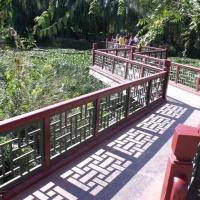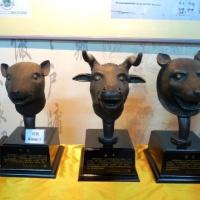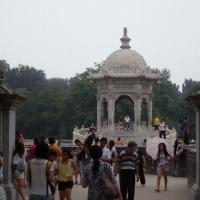The original Old Summer Palace (Yuan Ming Yuan) was laid out in 1707, during the reign of Emperor Kangxi and was on a much smaller scale. In 1725, under Emperor Yongzheng, the emperor gardens were greatly expanded. The emperor introduced the waterworks of the gardens which created some of the lakes, pools and streams which greatly complemented the rolling hills and grounds.
By the reign of the Emperor Qianlong, it was expanded again and developed into a set of interlocking gardens. Qianlong set the Jesuits to work as architects for a set of European palaces for the gardens- elaborate fountains, baroque statues, kiosks includes. By the middle of 19th century, the garden had undergone expansion in one form or another for more than 150 years.



The Old Summer Palace (Yuanmingyuan, Yuanming Garden) is commonly known as the "Garden of Gardens" in China. It consists of the Garden of Perfect Brightness proper, the Garden of Eternal Spring, and the Elegant Spring Garden; totally they covered an area of 350 hectares (the water surface is about 140 hectares).
The gardens had thousands of pavilions, temples, galleries, halls, lakes, bridges, rockeries, and many rare birds, beasts, trees and flowers, etc. Many famous landscapes of southern China had been reproduced in the gardens (such as the Suzhou Lion Grove, the Ten Famous Sights in Xihu Lake and so on), countless invaluable Chinese art masterpieces and antiquities were stored in the halls, making the palace the largest museum in the world.
Some unique copies of literary work and compilations were also stored inside the gardens.
Unfortunately, in the second Opium War (1860), the British and French troops thoroughly plundered and destroyed the Old Summer Palace in fire and sent all the booties to their countries. Since the Chinese pavilions and temples were made of wood they did not survive fires, but a marble facade some broken columns and traces of the fountains stick out of the rice paddies.
During the reign of Emperor Tongzhi (1862-1874), the palace was restored for the residence of Dowager Ci'xi. But by 1900, the palace was re-destroyed and looted again by the Eight Power Allied Force (Japan, British, French, Germany, Russia, America, Italy, and the Austria-Hungary).



After the founding of the People's Republic of China, the Chinese government attaches great importance to protect the ruined site of the Yuanmingyuan, some sights were restored. The site was open to the public and named Yuanmingyuan Park (or Yuanmingyuan Site Park). The destroyed palace was designated a heritage site of Beijing. Today, it is regarded as a symbol of foreign aggression and humiliation in China. It has become a living 'Educational Base of Patriotism' of all Chinese people.
To date, numerous priceless relics which were looted from the Old Summer Palace have been remained in the foreign museums, libraries and private collections. They are the living evidence to reveal the predators' impudence and voraciousness.
The Old Summer Palace (Yuanmingyuan) is situated just outside the west gate of Tsinghua University, north of Beijing University (Beida), and east of the Summer Palace. It can be reached on foot (about half an hour) or by bike from Beida - go north from Beida, turn right along the road to Tsinghua University, detour left into the rice fields- and then ask whoever happens to be wandering by.
